TVC + Content Production in Australia and New Zealand: State of the Industry 2022
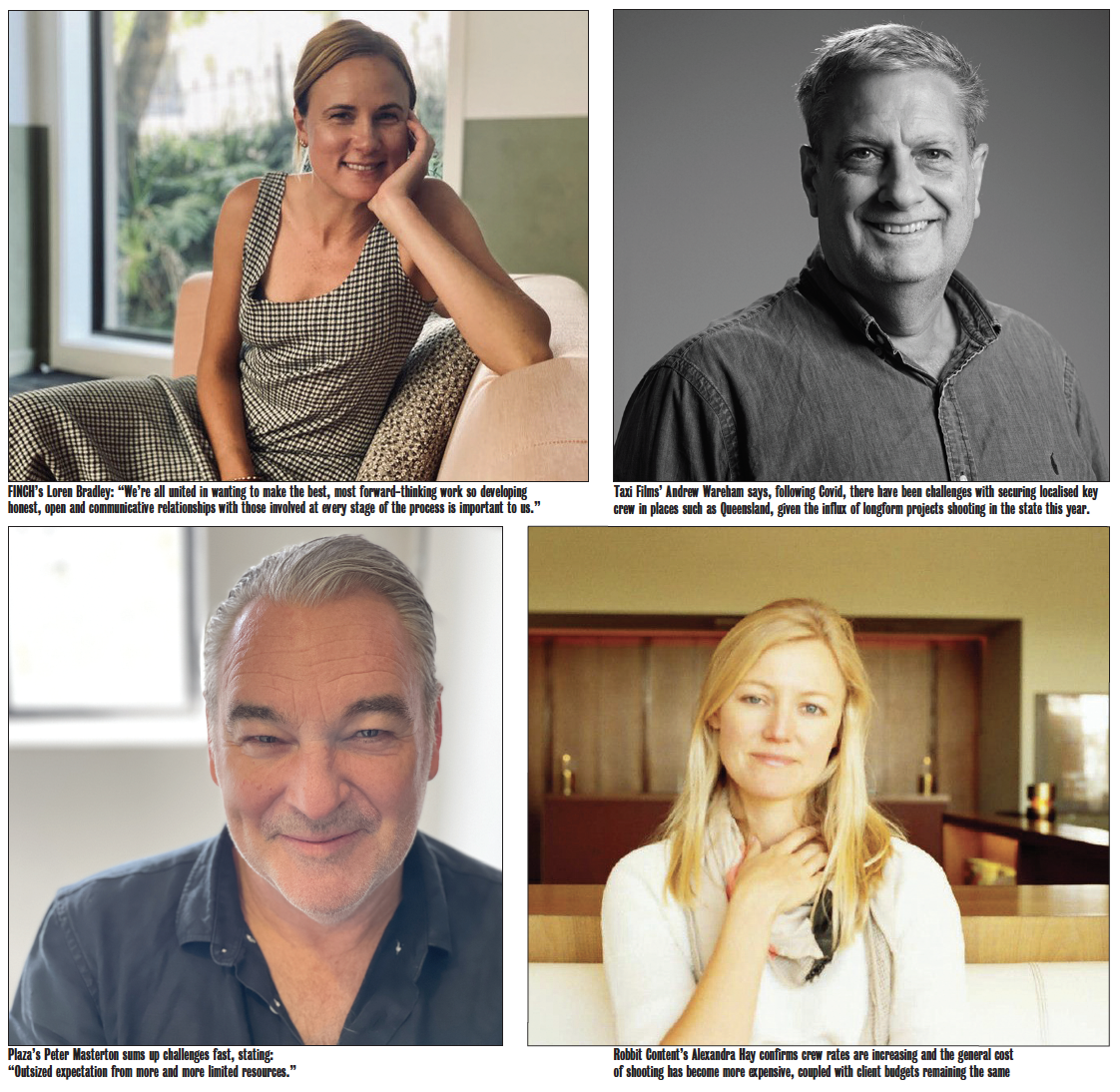
A thirst to discover fresh, diverse storytellers and a renewed appreciation for craft’s reliance on focussed collaboration, Australian production companies have emerged from the pandemic with a new set of protocols and a renewed attitude for embracing change. Identifying positives from the challenge, such as improved systems and new modes of communication, the industry’s key players give Campaign Brief an exclusive from behind the camera.
The key to making innovative dynamic work is a team that can check for each other’s blind spots. Whilst pushing and challenging one another, FINCH executive producer Loren Bradley says a solid production team ensures a firm delivery on promises. It’s this spirit of collaboration, she believes, that also extends to agency and client relationships.
“We’re all united in wanting to make the best, most forward-thinking work so developing honest, open and communicative relationships with those involved at every stage of the process is important to us.”
Faced with increasing time pressures and tighter schedules, Photoplay executive producer Florence Tourbier admits producers have to be extra buttoned down, yet more creative, in order to discover the most effective avenues to protect and nurture craft.
“Craft is a labour of love and time so tighter schedules are most definitely counter to the process of creating. And, it can seem at times rather absurd when production schedules we are being dealt with are so skewed in favour of research leaving no time for decent pre or post production – you run the risk of shooting yourself in the foot from the outset.”
To get around this, Photoplay implements creative planning that allows for staggered schedules and multiple concurrent work streams to maximise timeframes — whether it’s allowing for R and D and pre-vis time for technical jobs, or concept art and illustration for design- heavy sets or costumes, construction time for builds or simply good old fashioned ‘making’ time for intricate miniature sets and figurines.
Interestingly, Revolver managing director and owner/partner Michael Ritchie has seen the year cater to larger projects with more appropriate schedules and budgets.
He says: “Those clients are then getting a level of work that is a cut above. I am saying this because some clients see what good planning can deliver. The caveat to a good schedule needs to be backed by the appropriate budget. There is still this old way of thinking that giving us a lot of time with less money will work – mostly it doesn’t, it’s simply more expensive to the production. The scope, budget and schedule need to be talking to each other in the one conversation.”
To meet the needs of tighter schedules, Entropico has expanded its capabilities to include a new music and sound team, as well as a photography and cinematography department.
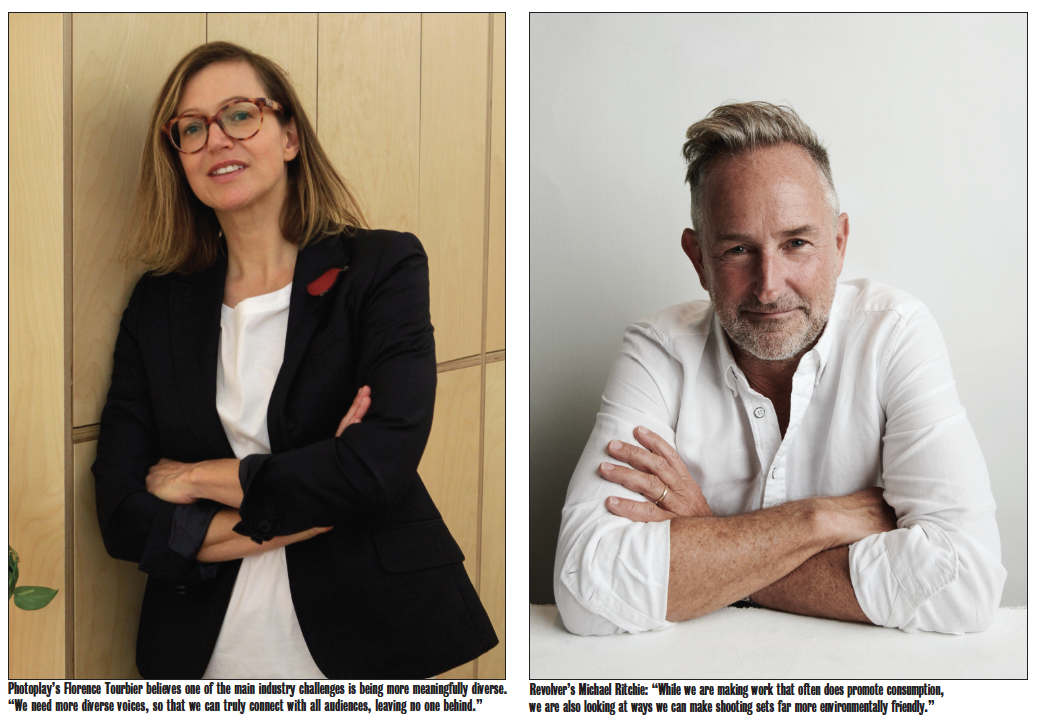
Entropico executive producer Ainslee Littlemore says: “Recently we’ve gone full Grand Designs at our Alexandria headquarters with editing and sound suites and a large multi-purpose studio.”
The production house has also grown its design and animation studio so more elements of the crafting process, including illustration and 3D, are now all under the one roof.
Entropico co-founder & executive producer Erin Moy adds: “Adopting technologies like Unreal Engine has also helped us to evolve our set build renders and post-production workflows in a big way. We also bring in a specialist freelance team for projects but having really diverse expertise in-house means we can be efficient, effective and innovative.”
At the forefront of everything, is of course the desire to create beautiful work.
Unlisted executive producer Anita Emor says: “To maintain that level of craft in this frantic climate boils down to being strategic in the projects that we choose to pitch on as well as being thorough in the planning and research stage of an inquiry.”
Within Australia, Unlisted’s work is primarily from the east coast. However, the production house has created a handful of films for clients in Perth and New Zealand.
“Our distributed model means we now have key team members in Perth, Sydney, Adelaide and Auckland, which is organically strengthening our connections with other Australian and New Zealand cities.”
Since launching in 2020, Unlisted has quickly garnered recognition throughout the APAC region. The production company is fortunate that more than 50% of its work is high budget creative briefs from predominantly Singaporean and Chinese agencies, for brands such as SK-II, Coca-Cola, Oppo and Pepsi.
Admitting tight budgets and schedules are a continuous challenge, Emor says sourcing and keeping talent is challenging, along with figuring out new ways to engage with remote based clients.
A result of many agencies adapting to a flexible working environment, The Pool Collective account and operations manager Courtney Lewis finds there is a significant disconnect, resulting in incomplete or loose briefs, paired with unrealistic budgets and timings.
Lewis argues: “Rather than seeing this as an impediment, it can be an opportunity to become involved in the early stages of a job. This way, production houses can contribute to the creative process, enabling work to be produced that exceeds original agency and client expectations.”
On the talent shortage front, Sweetshop Australia managing director Edward Pontifex says whilst it’s easing compared to previous years, he has still experienced a talent issue while the number of jobs in production have increased.
Pontifex explains: “This has been largely because of workers in isolation and the vast amount of commercial and long form content Australia is currently producing. Overall, I just don’t think we have enough really great experienced people for the amount of content that we’re producing.”
At Plaza Content, executive producer Peter Masterton sums up challenges fast, stating: “Outsized expectation from more and more limited resources.”
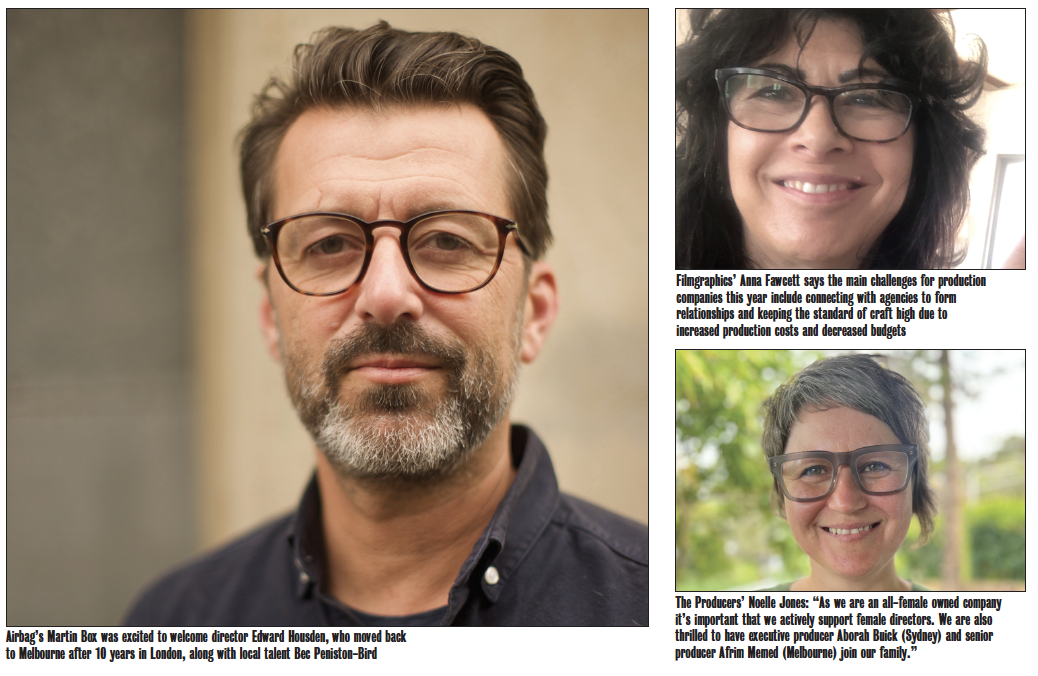
Filmgraphics executive producer Anna Fawcett says the main challenges for production companies this year include connecting with agencies to form relationships and keeping the standard of craft high due to increased production costs and decreased budgets.
Clockwork Films managing director Jamie Cohen also points to the rapid increase in costs.
“There was a price increase in response to Covid (after a long period of rates not moving) and more recently everything has gone up significantly,” he says, adding: “A Screen Producer’s survey indicated some roles have increased by as much as 80% and the problem is client budgets are set annually and lag cost increases. Cost increases have more to do with pent up demand, although a background of inflation has provided cover for crew.”
Cohen says the most obvious in-demand role in production has become, unsurprisingly, a VT to provide video streaming to remote clients and agencies. He adds: “Even after Covid, FWAs have become more common, and this is likely a production trend here to stay.”
In Pursuit of People
A number of specific production roles have become more in demand and Fawcett at Filmgraphics points to the director’s assistant fast becoming a critical role in the pitching process. She explains: “With every project requiring at least three directors to present a treatment, this role will always be in demand.”
The Producers executive producer Noelle Jones believes anyone who invested in a remote streaming service has certainly invested well.
She adds: “We are now using this tool to make our productions more sustainable by reducing the amount of travel where possible.”
This year The Producers partnered with the Honor Society, with offices in New York and Los Angeles, and creative studio Bestia based in Argentina. On Australian soil, the production house expanded its roster to include directors Aimée-Lee Xu Hsien and Olivia Altavilla.
“As we are an all-female owned company it’s important that we actively support female directors. We are also thrilled to have executive producer Aborah Buick (Sydney) and senior producer Afrim Memed (Melbourne) join our family.”
Limehouse senior producer Ashlee Savins suggests freelance producers with VFX and post experience are highly sought after. The production house recently brought on board a new CGI talent and an experienced senior creative retoucher. Savins says: “It can be tricky to find new freelancers as many went fulltime during Covid, however that is still the path we take before hiring talent – we work with them as freelance first to make sure they are a good fit, culturally as much as a test of their skills.”
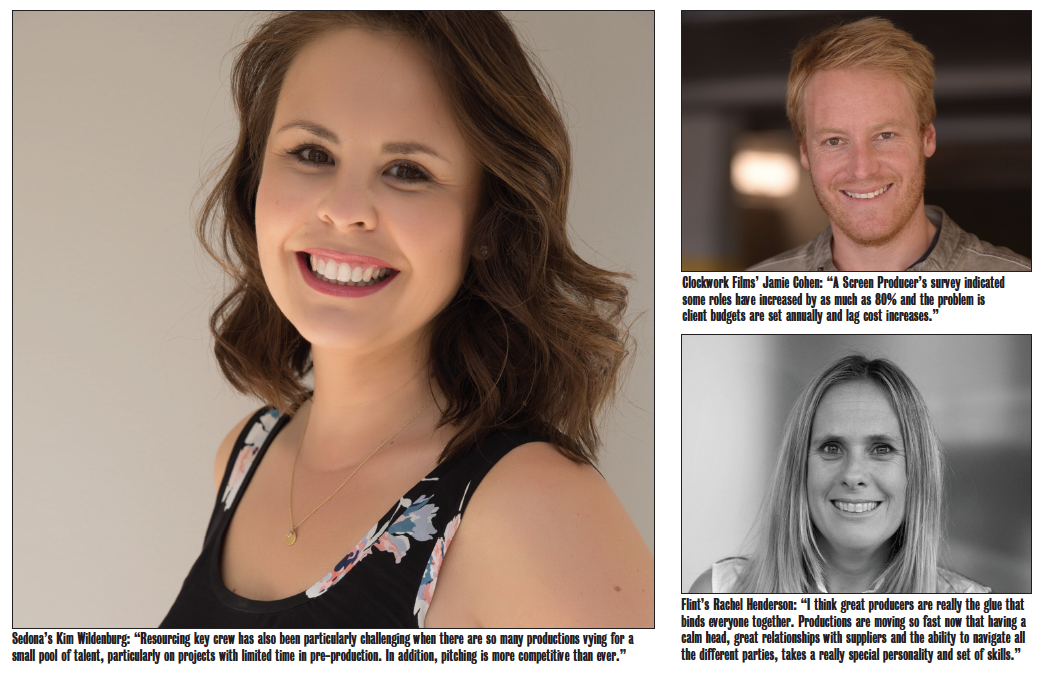
According to Taxi Film Production managing director & executive producer Andrew Wareham, following Covid, there have been challenges with securing localised key crew in places such as Queensland, given the influx of longform projects shooting in the state this year.
Taxi Film Production general manager Kohbe Vela-Smith is however thrilled that the company’s Tasty Pictures arm was able to attract tabletop director/producer Benjamin Flaxman exclusively.
Vela-Smith says: “Ben is consistently voted in the top 15 tabletop directors in the world and to have that talent available in Australia and exclusively linked to our Tasty specialised tabletop studio and production business has been a huge coup for us and our clients.”
Earlier this year, Taxi also welcomed one of Australia’s leading drama narrative directors, Emma Freeman.
Flint co-founder and executive producer Rachel Henderson has taken on three new additions to the team including Jeremy Shaw, Michele Aboud and Matt Cherubino. When asked what roles are most in demand, she says: “I think great producers are really the glue that binds everyone together. Productions are moving so fast now that having a calm head, great relationships with suppliers and the ability to navigate all the different parties, takes a really special personality and set of skills.”
Scoundrel co-founder and executive producer Adrian Shapiro agrees, stating: “I think skilled producers have become more in demand as the industry definitely needs more of them for the amount of work that we’re all creating.” He adds Scoundrel is not producing as many global briefs compared to the lockdown era with projects mainly arriving from agencies in Australia and New Zealand.
This year Sedona founder and managing director Kim Wildenburg was excited to expand into Victoria with the hire of executive producer Cinnamon Darvall.
“Cinnamon is extremely well regarded and a seasoned producer, having joined us from her recent roles of national head of broadcast at McCann and head of TV at Leo Burnett. We also signed the award-winning directing collective StyleWar to our roster which is very exciting!”
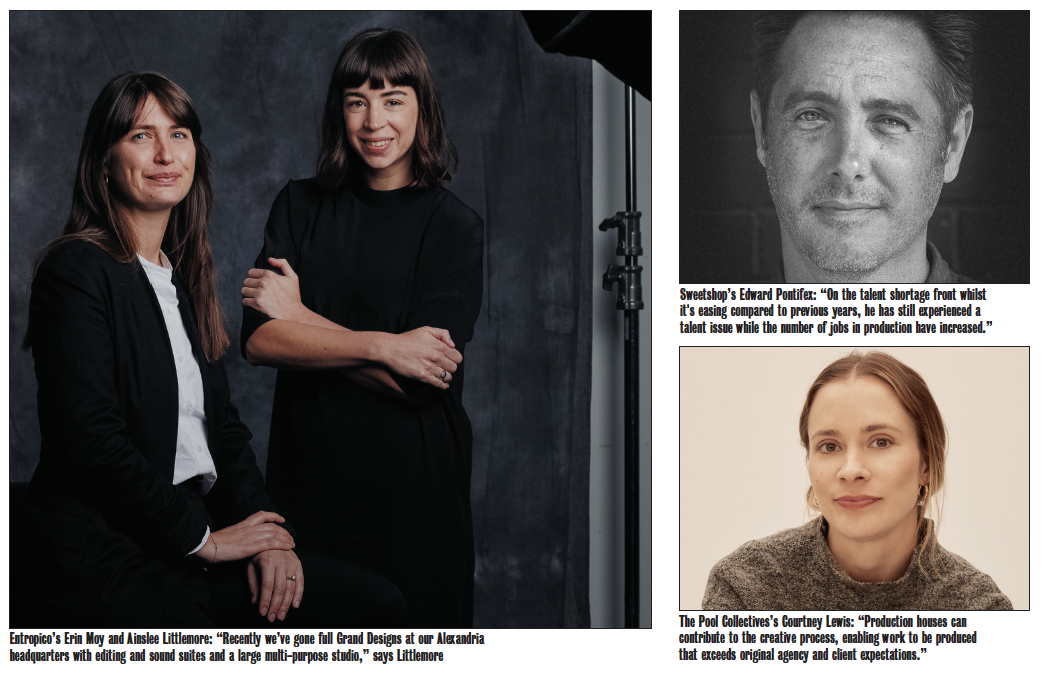
She says roles in demand include location scouts, director’s assistants, DOPs and production designers, along with post production and VFX partners also having limited availability.
“Resourcing key crew has also been particularly challenging when there are so many productions vying for a small pool of talent, particularly on projects with limited time in pre-production. In addition, pitching is more competitive than ever.”
Also expanding this year, Film Construction embarked on the opening of a photography division.
Film Construction executive producer and partner Belinda Bradley says partnering with photographer Victoria Baldwin as joint stills executive producer, the venture is being met with real enthusiasm. Housing lifestyle photographer Jason Ierace, beauty and editorial photographer Michele Aboud and food photographer Victoria Baldwin, Bradley says there are more announcements in the wings, adding: “The photography division has been brewing for a while and it is baked into our DNA as a company. We now represent directors and photographers, and after 25 years, this is a big deal!”
Film Construction also expanded its film roster with new talent including Tom Wilson, Michele Aboud, Brendan Canty, Chris Clark, Aimée-Lee Xu Hsien and Ayla Amano.
Pointing to the challenges faced in New Zealand, Bradley says the industry struggled through lockdowns, with the streaming giants block-booking all the studios and the country’s favourite crew.
Pointing to crew challenges in Australia, Rabbit Content managing director, executive producer and partner Alexandra Hay confirms crew rates are increasing and the general cost of shooting has become more expensive, coupled with client budgets remaining the same.
She adds: “There are often a huge number of deliverables that push up talent and post costs and dilute the overall budget. It is always a negotiation to agree on a number that will allow us to execute the script to the level that everyone is proud of and to create something that works for the client.”
Collider had great success welcoming to Australian shores and its roster directors Nash Edgerton, Spencer Susser and Beatrice Pegard.
Collider managing partner and executive producer Rachael Ford-Davies says: “The global relocation trend has certainly benefited Australia and New Zealand with incredible talents such as these working locally.”
Sweetshop Australia also managed to bring on new talent, signing three very different next generation directors Max Barden, Phebe Schmidt and Jared Daperis. The production house also signed highly acclaimed director Joshua H Walker along with comedy director Trevor Clarence, who signed in September this year.
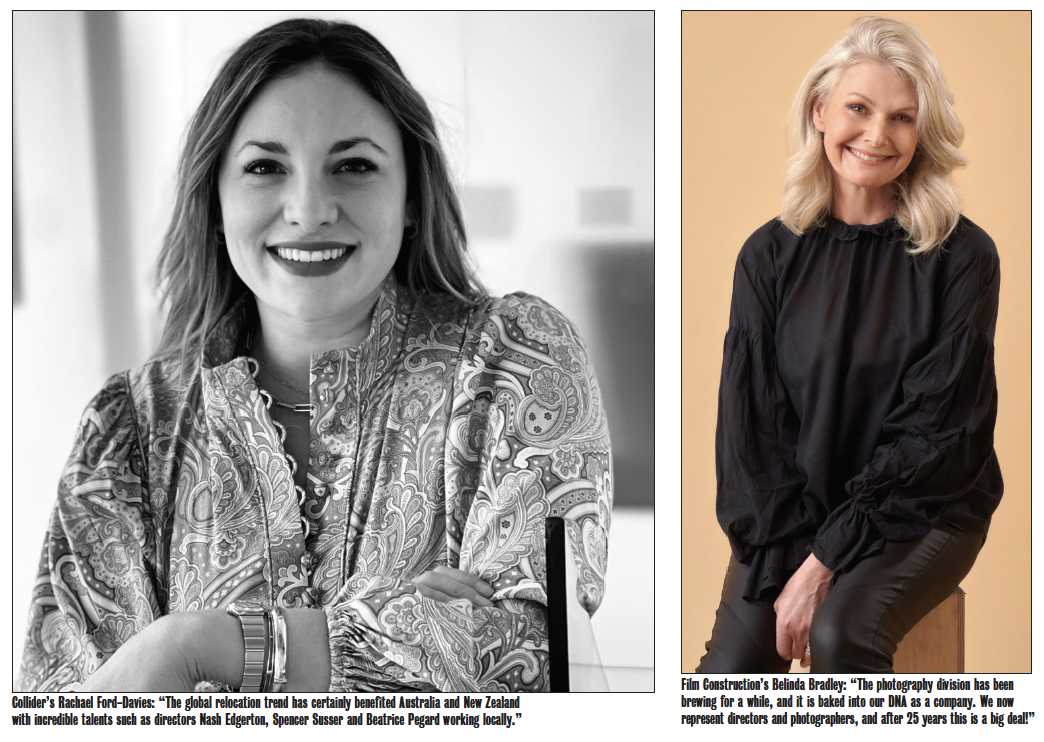
Airbag executive producer and head of production Martin Box was excited to welcome director Edward Housden, who moved back to Melbourne after 10 years in London, along with local talent Bec Peniston-Bird.
Says Box: “I anticipate great things from them both, along with Selin Yaman, who has joined the production team and will greatly increase our knowledge and experience.”
Unlisted also welcomed new faces with Hugo Jackson joining as creative director based in Sydney. Originally from France, he trained at ESMA, a reputable VFX college in Montpellier and following graduation was snapped up to get on the tools for a good stint at The Mill London before moving to Sydney five years ago. The production shop also extended its global team, so in addition to producers in Australia, New Zealand and China, it added to the production team Julie Murnaghan in Dublin and Timo Ramu in Helsinki. Both are experienced senior producers in animation and VFX.
Says executive producer Emor: “Senior producers and executive producers seem to be four-leaf clovers of a sort. With the model of work moving to a hybrid and distributed model there is greater demand for experienced producers who are capable of working independently.
Unfortunately, this can impact the training and development of junior staffers, co-ordinators, production assistants and junior producers. We acknowledge this and try to combat it by involving the junior team in meetings and communication that they’re typically not privy to in a physical studio setup.”
This year Plaza Content welcomed new DP/director Susie Stitt and London based legend Kevin Thomas.
Clockwork Films was equally excited to have Josh Nicholas join as production manager along with directors Maeve McKenna, Hans Emanuel, Lincoln Caplice, Matt Hols and Tobias Nathan.
This year Entropico made a bootleg episode of Australia’s Got Talent and in the process appointed executive producer Ainslee Littlemore, in addition to hiring practitioners across sound, copywriting, 3D animation and finance. And, perhaps most excitingly, the production house scored head of people & culture Tanisha Rodriguez to support and foster its growing roster.
Bradley at FINCH says she’s lucky to have EP Nick Simkins now working beside her as EP.
“Nick’s worked at FINCH for many years now, and has the talent and drive that makes the job with him a pleasure. We’ve also been working with some incredible off-roster directors, on productions with smaller budgets. That’s been hugely rewarding. We’re committed to raising up fresh voices in the industry and working with filmmakers outside our roster helps us see new ways of doing things. It’s nice to have your opinions shaken up and working with a diverse array of talent does just that.”
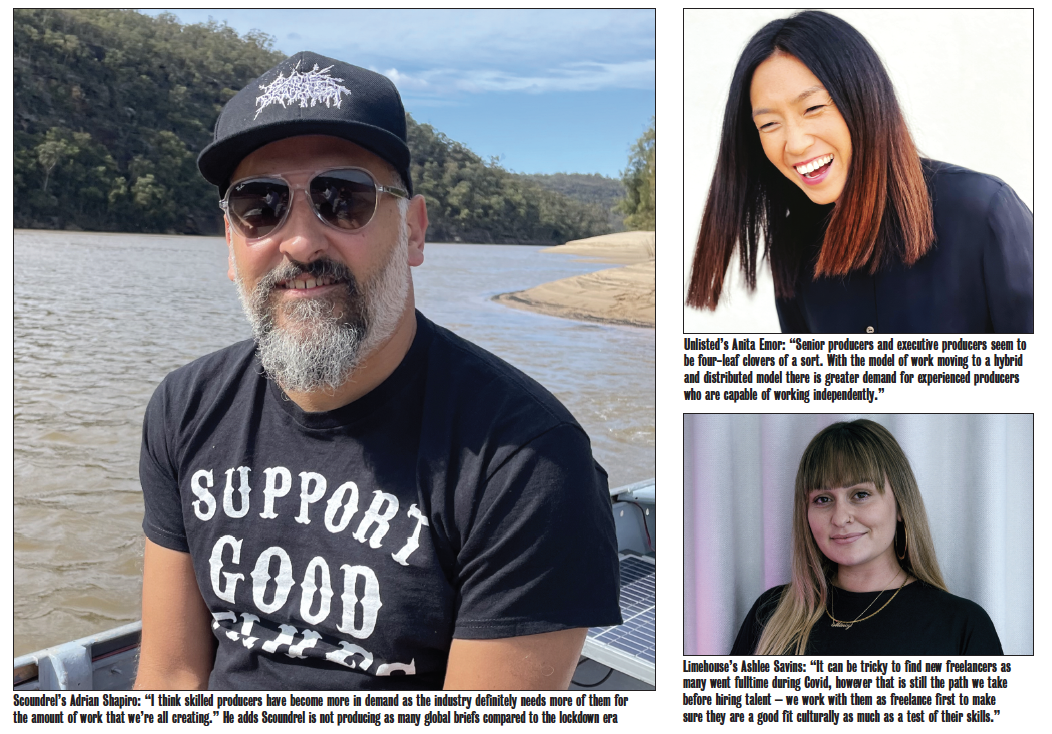
Photoplay has also benefited from some fantastic additions this year. Tourbier says: “Writer-director Michael Gupta joined our Playtime roster this past year and is one to watch. He has this amazing knack to bring to life stories from the fringes with so much truth and authenticity, creating these raw cinematic moments along the way. And he takes such a considered approach to his characters, taking us inside their mind and bringing a new perspective.”
Photographer-director Sarah Adamson is another new rising star, joining the Playtime roster.
“Sarah was already a highly sought after and busy fashion/lifestyle photographer, but this year has seen her career move into commercial direction, bringing with her general awesomeness, vibrant visual style and offbeat performance direction to the roster.”
On the photography side of things, the company also signed Adam Ferguson.
Tourbier believes one of the main industry challenges is working harder to be more meaningfully diverse.
She says: “Thankfully this is starting to happen, but we still have a long way to go for it to be less tokenistic. We need the inclusion of more diverse voices, so that we can truly connect with all audiences, leaving no one behind.”
Photoplay has proudly been an advocate for Free the Bid and gender equality in the industry for years, particularly in directing, which is still so male dominated.
“We also work tirelessly to have diversity represented on our roster of directors and photographers – across gender, race, sexuality and ability. But we need to do more. We need more indigenous voices and more directors from less privileged socio-economic backgrounds.”
Ritchie at Revolver also thinks the industry is undergoing an existential crisis moving into the future.
Says Ritchie: “While we are making work that often does promote consumption, we are also looking at ways we can make shooting sets far more environmentally friendly. I know this is yet another conflict that living in our times throws at us, but all of that aside, like the products we advertise, we do have to be better.”
Ritchie commends the CPC for doing a good job in being a centralised body to spread best practice on sustainability.
“Pip Smart and Anna Mannix are pushing that area for us and it’s already changing things significantly. On top of that, we are all continuing to push our companies to genuinely promote diversity, and to be honest, the production industry can actually be the world’s best practice if it’s really pushed. We have an industry that is visible and creates work that many people see, we can make change and it actually has an effect on our society – let’s not waste that. I personally feel that we can always do more in our company and I hope you all feel the same way.”
